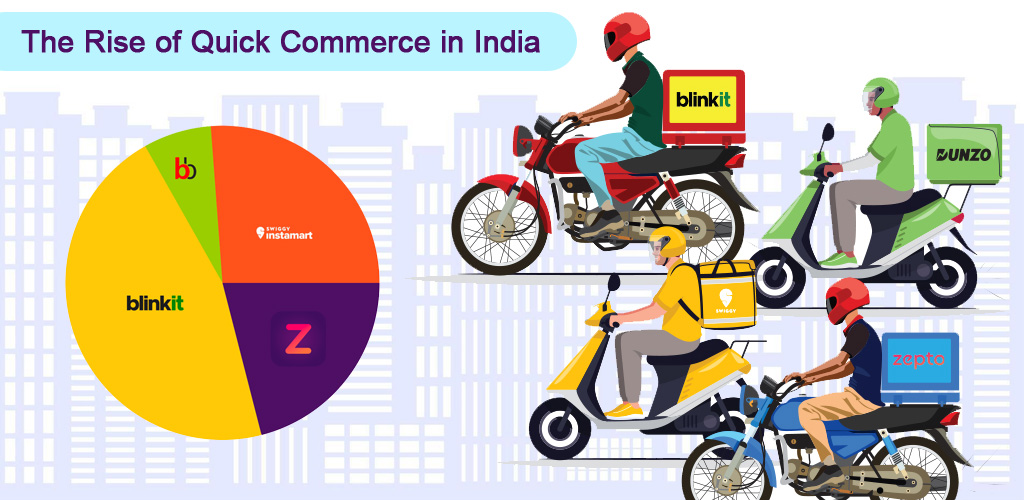Quick Commerce (Q-Commerce) has swiftly transformed India’s retail landscape, offering ultra-fast delivery services that cater to the modern consumer’s demand for speed and convenience. In 2024, the Indian Q-Commerce market was valued at approximately USD 3.34 billion, with projections to reach USD 9.95 billion by 2029, growing at a compound annual growth rate (CAGR) of over 4.5% during the forecast period. Source: Mordor Intelligence
This case study examines the growth trajectory of Quick Commerce in India, the driving forces behind its expansion, the challenges it faces, and potential solutions for sustainable development.
The Growth Trajectory
The Indian Quick Commerce market has experienced significant growth over the past few years, with sales increasing by over 280% between 2022 and 2024. Source: Economic Times
Key milestones include:
- 2019–2020: Dunzo introduced the hyperlocal delivery concept, paving the way for Quick Commerce.
- 2021: The COVID-19 pandemic accelerated demand for home delivery services. Blinkit (formerly Grofers) and Zepto pioneered the sub-30-minute delivery promise.
- 2022–2023: BigBasket launched BB Now, delivering essentials in under 30 minutes, leveraging its robust supply chain. Reliance JioMart Express entered the market, intensifying competition.
- 2024: Amazon began trials for 15-minute grocery deliveries in India, joining the Quick Commerce race alongside established players like Swiggy’s Instamart and Zomato’s Blinkit. Source: Reuters
Examples of success:
- Zepto: Founded in 2021, Zepto became a key player with its 10-minute delivery promise, valued at USD 900 million by 2023. It focuses on metros like Mumbai, Delhi, and Bengaluru.
- BigBasket (BB Now): Leveraging its parent company Tata Group’s resources, BigBasket launched BB Now to compete in the Quick Commerce space. Its strong brand recognition and existing customer base provided a significant advantage.
- Swiggy Instamart: Swiggy’s Quick Commerce vertical expanded its operations nationwide, delivering over 2 million orders weekly by late 2023.
- Blinkit: After rebranding and partnering with Zomato, Blinkit consistently achieved over 100,000 orders daily in urban markets.
Key Drivers of Growth
- Evolving Consumer Expectations
Urban consumers, especially millennials and Gen Z, demand convenience and instant gratification, making Quick Commerce highly appealing. - Technological Advancements
- Companies utilize AI-driven inventory management and route optimization for faster deliveries.
- The dark store model ensures proximity to customers, minimizing delivery times.
- Rising Smartphone Penetration
With over 700 million smartphone users, increased internet access has created a fertile market for app-based commerce. - Funding and Investments
- Zepto raised USD 200 million in funding in 2022, fueling expansion.
- BigBasket benefits from Tata’s investments, enabling it to scale BB Now efficiently.
- Shift to Urban Lifestyles
Growing nuclear families and working professionals in metros drive the demand for faster, smaller, and frequent purchases.
Challenges Faced by Quick Commerce in India
- Profitability Issues
- The cost of maintaining dark stores, delivery fleets, and frequent discounts creates pressure on margins.
- Essentials have low-profit margins, making the model heavily reliant on volume.
- Logistics and Workforce Concerns
- Delivery personnel face safety issues due to time pressures.
- High attrition rates add to operational costs.
- Intense Competition
With established players like BigBasket and Reliance entering the segment, smaller startups face challenges in sustaining market share. - Consumer Trust
Ensuring consistent product availability and quality, especially during peak hours or adverse conditions, is a critical challenge. - Regulatory and Safety Concerns
Regulatory bodies are scrutinizing delivery speeds due to traffic safety and labor welfare issues.
Potential Solutions
- Streamlining Operations
- AI and Predictive Analytics: Enhance demand forecasting and reduce inventory wastage.
- Optimize delivery routes to consolidate orders and reduce delivery costs.
- Introducing Sustainable Pricing Models
- Move away from heavy discounting to subscription-based loyalty programs.
- Partner with local suppliers and brands to improve margins.
- Enhancing Workforce Welfare
- Flexible delivery schedules and safer practices can improve rider retention.
- Offering insurance and incentives for delivery personnel ensures satisfaction and safety.
- Leveraging Partnerships
- Collaborate with local businesses for hyperlocal fulfillment.
- Partner with governments for safer traffic and labor practices.
- Building Consumer Loyalty
- Focus on loyalty programs, personalized offers, and gamified shopping experiences.
- Consistent delivery of quality products and reliable service times will build trust.
Conclusion
Quick Commerce has revolutionized retail in India, becoming indispensable for urban consumers. Companies like Zepto, Blinkit, Swiggy Instamart, BigBasket’s BB Now, and Reliance JioMart Express have harnessed.
